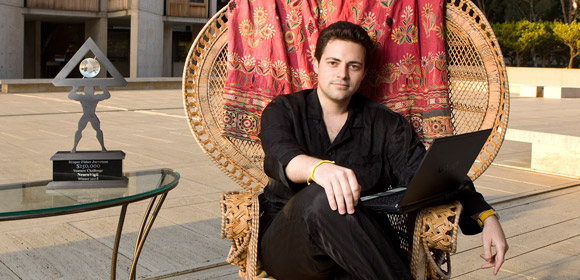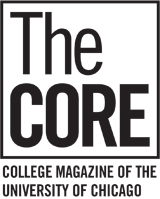
Beyond the Quads
Mind Reader
Alumnus Philip Low’s iBrain monitors waves. It’s also making them.
A mathematician turned neuroscientist turned CEO, Philip Low, AB’00, still thinks of himself as a math guy. At the heart of his surprisingly successful biotech startup is a simple algorithm. The company’s products may have the power to radically change the way modern medicine treats illnesses of the brain.
Born in Austria and now a Canadian citizen, Low finished high school in Switzerland at age 16. He had a strong interest in mathematics and physics, and gravitated toward the University of Chicago for its strength in those fields. Low was also very attracted by the Common Core; the European educational system pushes students to specialize early, and he wanted to avoid that.
A Core class put him on the road to neuroscience. As a math major, Low had initially taken a biology class “reluctantly,” but soon warmed to studying living things. The next summer, he secured a summer research position at Harvard Medical School. “After nine weeks, we discovered that a new compound could block the growth of fibroid tumors. I was 19 years old at the time. It was very exciting.” In his final year in college, Low’s interest in biology led him to take graduate courses in computational neuroscience.
“By the time I graduated, I was torn between cancer research and computational neuroscience,” explains Low. “So I wrote a letter to the only person I knew who would know a little bit about molecular biology and neuroscience.” That was Francis Crick, codiscoverer of DNA, who had an active neuroscience research program at the Salk Institute. Crick invited Low to work on his PhD with him, but Low didn’t feel he had enough biology training to work with the Nobel laureate. To shore it up, he snagged a job at the U of C with Daniel Margoliash, a professor on the committees of neurobiology and computational neuroscience, studying finches.
Margoliash’s lab was studying the birds’ brainwaves for evidence that the finches were rehearsing their songs during rapid eye movement (REM) sleep, a phenomenon known as “sleep learning” that had been observed in mammals only until that point. The results were inconclusive. After a year Low enrolled in a doctoral program run jointly by the Salk Institute and the University of California, San Diego, where he would earn his degree with Crick as an adviser. He returned to Margoliash’s lab in Chicago the summer after his first year of coursework, and this time managed to develop an algorithm to analyze the birds’ brain waves. In doing so, he was able to prove conclusively that birds in fact experienced REM sleep.
The bird research made Low want to learn how researchers classified brain waves in humans. To his astonishment, even at the time, in 2001, the entire process was manual; technicians judged by eye what each electroencephalogram (EEG) reading meant. Low returned to the Salk Institute determined to discover an algorithm that would allow a computer to make those judgments. His advisers were worried that the goal was too ambitious and would derail his thesis work. “I ended up working on this project in secrecy for several years at the Salk Institute,” he says, and had to pretend to be working on another topic to avoid his advisers’ suspicion.
Traditionally, doctors had taken multiple EEG readings from multiple electrodes spaced around the brain, a labor-intensive process that could result in dozens of separate data streams, each of which provided a different signal. One of the breakthroughs that allowed Low to crack his problem was the discovery of a process to amplify the signal from one electrode; using just one electrode, the algorithm could tease out multiple waves from all parts of the brain, faint though they may be.
When his adviser realized that Low had violated his order, Low told him that not only did he think he could find the algorithm that mapped the brain waves, but the solution might be elegant enough to fit on one page. Sure enough, his thesis describing the algorithm was just that long.
The commercial potential was obvious; the Salk Institute immediately filed patents around Low’s discovery, and even before receiving his doctorate Low had founded a company, NeuroVigil, to commercialize his work. Its first product, introduced in 2009, is the iBrain, a small, hand-held device with a single electrode. Its first application is with pharmaceutical companies, aiding in clinical trials of drugs. Low also sees a major market in sleep studies, citing the 70 million Americans with sleep disorders; traditional sleep studies require a battery of technicians and electrodes and overnight stay, but the iBrain might make it possible to do the entire study at home.
Running a business as a scientist-entrepreneur has its pluses and minuses. “I think it’s good for a tech CEO to be very close to the technology,” Low explains. “I enjoy being able to see all sides of the business.” On the other hand, his dual role meets with skepticism from some scientists, who see him as having “sold out,” while some businesspeople dismiss him as “just a scientist.”
Low has ambitious plans for NeuroVigil, which by all accounts is doing well: the company is already cash-positive without having to sell stakes of itself to investors, a rarity for biotech companies that didn’t start as a spinoff of a larger firm. The company is developing a way for iBrain devices to relay their data back to a central database via cell phone. That database will become a “wonderful repository of data that we will be able to explore and mine” for diagnosis, including monitoring brain activity for warning signs of illness before physical symptoms occur.
On the basis of this promise, last year Low was named one of Technology Review’s< Young Innovators under 35, joining the ranks of Google’s Sergey Brin, Facebook’s Mark Zuckerberg, and the University of Chicago’s Milan Mrksich and Rustem Ismagilov. The best part for Low may be seeing his research change people’s lives. “By making this technology available to individuals, we could actually help them in a way that we cannot right now,” he says—an unusual and rich reward for a mathematician.
—Benjamin Recchie
Photo by Joe Belcovson

